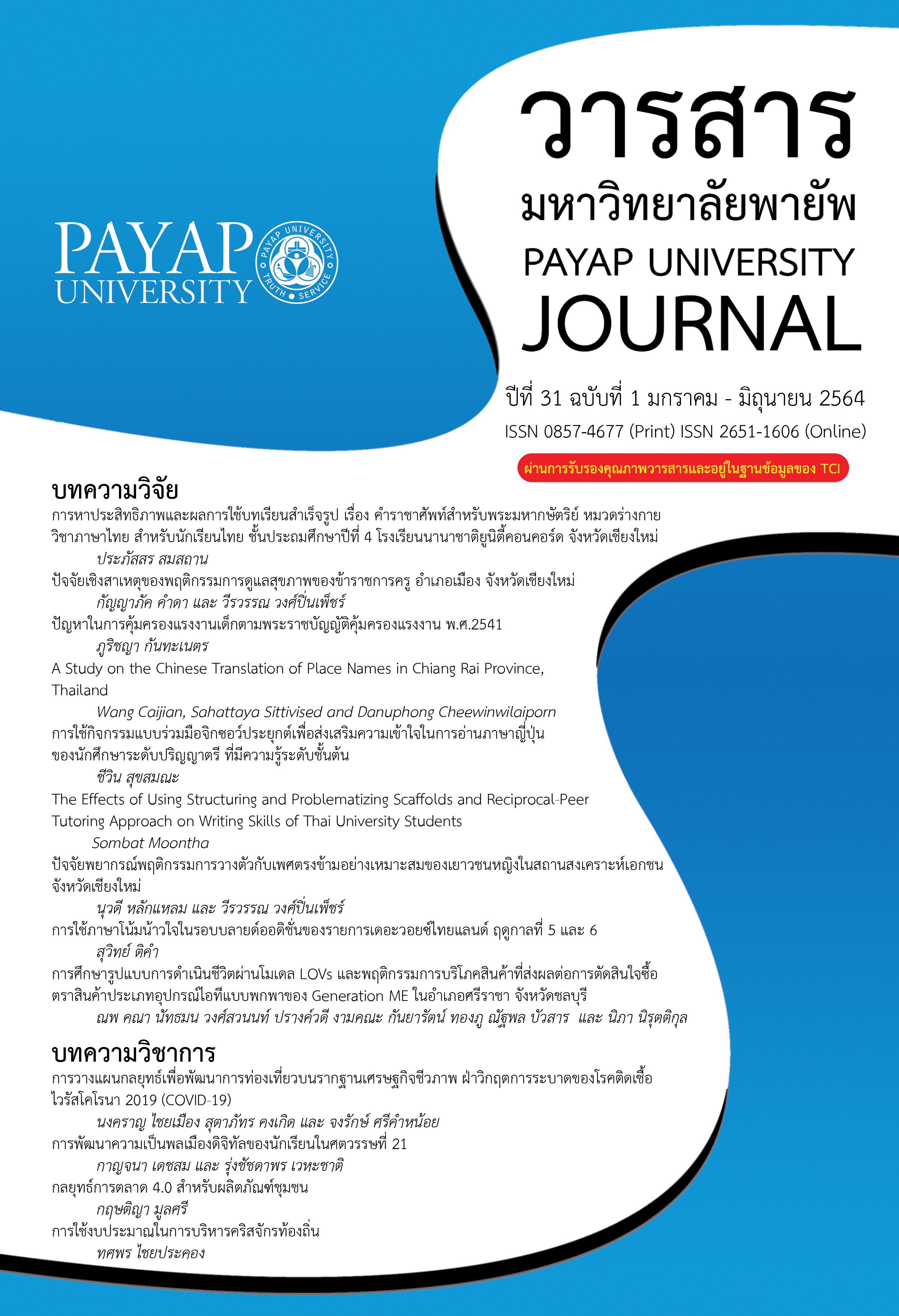กลยุทธ์การตลาด 4.0 สำหรับผลิตภัณฑ์ชุมชน
Main Article Content
บทคัดย่อ
บทความนี้มีวัตถุประสงค์เพื่อนำเสนอองค์ความรู้เกี่ยวกับการตลาด 4.0 และแนวทางดำเนินงานกลยุทธ์การตลาดสำหรับผลิตภัณฑ์ชุมชนในยุคการตลาด 4.0 ทั้งนี้ เนื่องจากการตลาดได้พัฒนาผ่านยุคต่าง ๆ จนมาถึงยุคการตลาด 4.0 ที่ผู้บริโภคมีส่วนร่วมในการให้ข้อมูลเกี่ยวกับสินค้า ผู้บริโภคจะรวมตัวกันเป็นกลุ่มชุมชนเสมือนด้วยความสมัครใจ เพื่อการสนทนาแลกเปลี่ยนข้อมูลและประสบการณ์ระหว่างกัน ซึ่งการสนทนาและข้อมูลที่แลกเปลี่ยนระหว่างกัน มีอิทธิพลอย่างมากต่อการตัดสินใจซื้อสินค้า และด้วยความก้าวหน้าทางเทคโนโลยีและอินเทอร์เน็ต ส่งผลให้ผู้บริโภคสามารถเข้าถึงอินเทอร์เน็ตได้ง่ายขึ้น ผู้บริโภคสามารถสืบค้นข้อมูลสินค้าหรือบริการได้โดยง่ายและรวดเร็ว การตลาดยุค 4.0 จึงมุ่งให้ผู้บริโภคเป็นศูนย์กลาง สร้างแรงบันดาลใจให้ผู้บริโภคร่วมสร้างเนื้อหาและสินค้า/บริการใหม่ มุ่งมั่นเสนอคุณค่าและความไว้วางใจจากผู้บริโภค โดยใช้เครื่องมือเชิงบูรณาการและสร้างปฏิสัมพันธ์ระหว่างการตลาดออนไลน์และการตลาดออฟไลน์ เพื่อให้ผู้บริโภคเข้ามามีส่วนร่วมมากขึ้น และเป็นการสร้างความสัมพันธ์ระหว่างธุรกิจกับผู้บริโภค รวมถึงความภักดีต่อแบรนด์ด้วย กลยุทธ์การตลาดสำหรับผลิตภัณฑ์ชุมชนในยุคการตลาด 4.0 ต้องมุ่งสร้างความสัมพันธ์และความไว้วางใจจากผู้บริโภค มุ่งให้ผู้บริโภคเข้ามามีส่วนร่วมในการให้ข้อมูลเกี่ยวกับสินค้า สร้างกลุ่มชุมชนเสมือนเพื่อแลกเปลี่ยนข้อมูลระหว่างกัน เพราะมีอิทธิพลอย่างมากต่อการตัดสินใจซื้อสินค้า ผู้ประกอบการธุรกิจชุมชนต้องมีการปรับเปลี่ยนกลยุทธ์ส่วนประสมทางการตลาด 4P’s เป็นกลยุทธ์ใหม่เรียกว่า 4C’s ประกอบด้วย C1 (การสร้างสรรค์ร่วมกัน) C2 (ระบบเงินดิจิทัล) C3 (การปฏิบัติการที่มีส่วนร่วมกัน) และ C4 (การเจรจาและการทำการค้า) โดยกลยุทธ์ 4C’s นี้ เป็นกลยุทธ์ส่วนประสมการตลาดที่เชื่อมโยงถึงเส้นทางผู้บริโภคใหม่ (5A's Model) ประกอบไปด้วย A1 (ช่วงรับรู้) A2 (ช่วงดึงดูดใจ) A3 (ช่วงสอบถาม) A4 (ช่วงลงมือทํา) และ A5 (ช่วงสนับสนุน) ทั้งนี้เพื่อสร้างผลลัพธ์ทางการตลาดของผลิตภัณฑ์ชุมชนที่มีประสิทธิภาพและสอดรับกับพฤติกรรมของผู้บริโภคในยุคปัจจุบันและอนาคต
Article Details
เอกสารอ้างอิง
กฤษณะ ดาราเรือง. (2560). การพัฒนาผลิตภัณฑ์และกลยุทธ์ทางการตลาดวิสาหกิจชุมชนบ้านเขาแหลม จังหวัดนครสวรรค์. สุทธิปริทัศน์, 31(100), 130-143.
กฤษติญา มูลศรี. (2562). นวัตกรรมและการตลาดดิจิทัลที่ส่งผลต่อผลการดำเนินงานของธุรกิจขนาดกลางและขนาดย่อมในประเทศไทย. MFU Connexion: Journal of Humanities and Social Sciences, 8(2), 36-62.
กศิพัฎญ์ ทองแกม และ โฆสิต แพงสร้อย. (2562) ปัญหาและแนวทางส่งเสริมการขายสินค้าโอทอปบนตลาดออนไลน์ เชิงพุทธในจังหวัดอุดรธานี. วารสารมหาจุฬานาครทรรศน์, 9(2), 4627-4644.
กุณฑลี รื่นรมย์. (2561). การกำหนดปัญหางานวิจัยด้านการตลาดดิจิทัลสำหรับประเทศไทยในอนาคต. จุฬาลงกรณ์ธุรกิจปริทัศน์, 40 (157), 100-140.
จุฬารัตน์ ขันแก้ว. (2562). กลยุทธ์การตลาดดิจิทัลและผลการดำเนินงานทางการตลาด หลักฐานเชิงประจักษ์จากธุรกิจบริการในประเทศไทย. จุฬาลงกรณ์ธุรกิจปริทัศน์, 41(159), 1-32.
ฉัตยาพร เสมอใจ. (2558). กลยุทธ์ตลาดสำหรับวิสาหกิจชุมชน: กรณีศึกษากระเทียมโทนดอง อบต. บางกร่าง จังหวัดนนทบุรี. วารสารวิชาการ มหาวิทยาลัยราชภัฏพระนคร, 6(2), 104-115.
ชัญญา แว่นทิพย์ และคะนอง พิลุน. (2559). ปัจจัยที่ส่งผลต่อความสำเร็จและความล้มเหลวของผลิตภัณฑ์ OTOP ประเภทผ้า และเครื่องแต่งกาย ของอำเภอสุวรรณภูมิจังหวัดร้อยเอ็ด. วารสารการเมืองการปกครอง, 6(1), 66-81.
ณัฐพล ใยไพโรจน์. (2560). Digital marketing: Concept & case study 4.0th edition. นนทบุรี: ไอดีซีฯ.
ธัญญ์รวี ธรศิริปุณโรจน์ กฤษฎา ตันเปาว์ และ กัญญามน กาญจนาทวีกูล. (2562). กลยุทธ์การตลาดสู่ความสำเร็จของการประกอบธุรกิจผลิตภัณฑ์สปา ผ่านช่องทางดิจิทัลในเขตกรุงเทพมหานครและปริมณฑล. วารสารสมาคมนักวิจัย. 24(1), 72- 84.
ธันยมัย เจียรกุล. (2557). ปัญหาและแนวทางการปรับตัวของ OTOP เพื่อพร้อมรับการเปิด AEC. วารสารนักบริหาร, 34(1), 177-191.
นงลักษณ์ จารุวัฒน์. (2554). การตลาด 3.0. กรุงเทพฯ: เนชั่นบุ๊ค.
______________. (2560). การตลาด 4.0. กรุงเทพฯ: เนชั่นบุ๊ค.
ประสิทธิ์ รัตนพันธ์ มนีรัตน์ รัตนพันธ์ และจาริณี แซ่ว่อง. (2561). การพัฒนาช่องทางการจัดจำหน่ายและการสร้างมูลค่าเพิ่มให้กับผลิตภัณฑ์ชุมชนประเภทอาหารในจังหวัดสงขลา. Journal of Community Development Research (Humanities and Social Sciences), 11(4), 42-51.
เปิด 3 ธุรกิจออนไลน์ ต้นแบบความสำเร็จ โมเดล Green e-commerce. (2559), สืบค้นเมื่อ 1 พฤษภาคม 2564. http://www.thaismescenter.com/เปิด-3-ธุรกิจออนไลน์-ต้นแบบความสำเร็จ-โมเดล-green-e-commerce/
พจน์ ใจชาญสุขกิจ. (2560). สื่อสาร บริหารแบรนด์ และพีอาร์ อย่างไร ในยุค Marketing 4.0, สืบค้นเมื่อ 3 กันยายน 2563. https://www.prthailand.com/images/articles/170809-1-expertcommu.pdf
พิริยะ เงินศรีสุข และ เสรี วงศ์มณฑา. (2563). แนวทางการพัฒนาการสื่อสารการตลาดแบบดิจิทัล สำหรับนักท่องเที่ยว 4.0. วารสารรัชต์ภาคย์, 14(34), 313 – 321.
ฟ้าพิไล ทวีสินโสภา. (2560). แนวทางการพัฒนาร้านขายสินค้าที่ระลึกเพื่อการพัฒนาการท่องเที่ยวเชิงชุมชน ในจังหวัดตรัง. วารสารวิจัยมหาวิทยาลัยเทคโนโลยีราชมงคลศรีวิชัย, 9 (1), 113-126.
ศิริภรณ์ พงศ์ลี้ สริณโญ สอดสี และเกตุวดี สมบูรณ์ทวี. (2560). แนวทางการพัฒนาวิสาหกิจชุมชนและช่องทางการตลาดมะเขือเทศราชินี กรณีศึกษา กลุ่มวิสาหกิจชุมชน ตำบลดอนตูม อำเภอบางเลน จังหวัดนครปฐม. ใน กองบริหารการวิจัย มหาวิทยาลัยนเรศวรวิจัย, นเรศวรวิจัย ครั้งที่ 13: วิจัยและนวัตกรรม ขับเคลื่อนเศรษฐกิจและสังคม (น. 1117-1124). พิษณุโลก: มหาวิทยาลัยนเรศวรวิจัย.
สำนักงานพัฒนาธุรกรรมทางอิเล็กทรอนิกส์. (2562). เอกสารการแถลงผลการสำรวจพฤติกรรมผู้ใช้อินเทอร์เน็ตในประเทศไทย ปี 2562, สืบค้นเมื่อ 22 เมษายน 2563. https://www.etda.or.th/publishing-detail/thailand-internet-user-behavior-2019-slides.html
สุรชา บุญรักษา. (2558). แนวทางการพัฒนากลยุทธ์การตลาดเพื่อสร้างการรับรู้คุณค่าขนมไทยใน จังหวัดสมุทรสาคร ตามแนวคิดเศรษฐกิจสร้างสรรค์. วารสารวิทยาการจัดการ มหาวิทยาลัยราชภัฎ นครปฐม, 2(1), 112-126.
เสรี วงษ์มณฑา และ ชุษณะ เตชคณา. (2560). การตลาด 4.0 ในบริบทประเทศไทย 4.0. วารสารเศรษฐศาสตร์และนโยบายสาธารณะ, 8(15), 1-16.
อุทิศ ทาหอม, สำราญ ธุระตา, ชุลีพร บุ้งทอง และ คเนศ วงษา. (2561). รูปแบบการเพิ่มมูลค่าผลิตภัณฑ์อาหารพื้นถิ่น “ตำเปียงทรงเครื่อง” เพื่อสร้างความเข้มแข็งของเศรษฐกิจชุมชนบ้านเสม็ด ตำบลหนองเต็ง อำเภอกระสัง จังหวัดบุรีรัมย์. วารสารพัฒนาสังคม, 20(2), 37- 60.
Andhyka, B. (2020). Marketing 4.0 a literature review. IOSR Journal of Business and Management (IOSR-JBM), 22(4), 49-52.
Erragcha, N., & Romdhane, R. (2014). New faces of marketing in the era of the web: From marketing 1.0 to marketing 3.0. Journal of Research in Marketing, 2(2), 137-142.
Ilic, D., Ostojic, S., & Damnjanovic, N. (2014). The Importance of marketing innovation in new economy. Singidunum Journal of Applied Sciences, 11(1), 34-42.
Kotler, P., Kartajaya, H., & Setiawan, I. (2017). Marketing 4.0 moving from traditional to digital. New York: John Wiley & Sons Inc.
Singh, T. P. & RatnaSinha. (2017). The Impact of social media on business growth and performance in India. International Journal of Research in Management & Business Studies, 4(1), 36-40.
Tanhnanchya. (2561). สรุปการตลาด 4.0 (Marketing 4.0): ทฤษฎีที่เราเคยเรียนมันเปลี่ยนไปแล้ว, สืบค้นเมื่อ 14 มีนาคม 2564. https://thezepiaworld.com/2018/10/13/marketing-4/
Wereda, W., & Wo´zniak, J. (2019). Building relationships with customer 4.0 in the era of marketing 4.0: The case study of innovative enterprises in Poland. Social Sciences, 8, 1-27.


